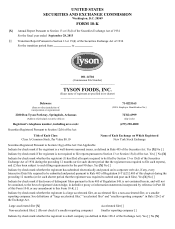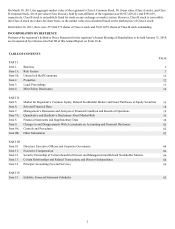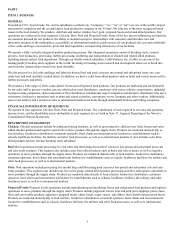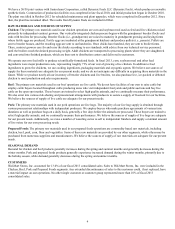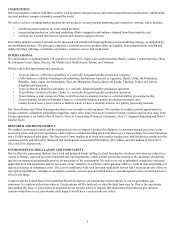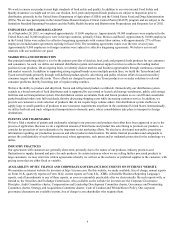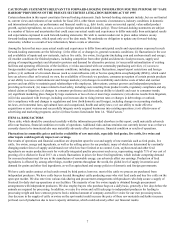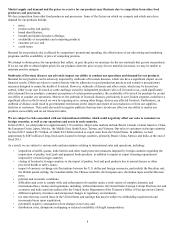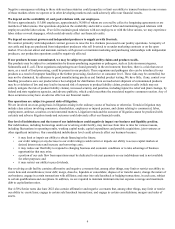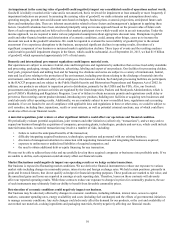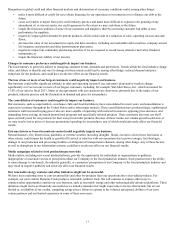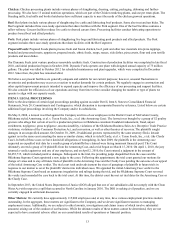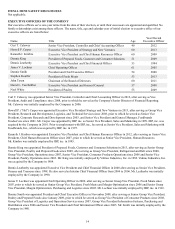Tyson Foods 2013 Annual Report Download - page 4
Download and view the complete annual report
Please find page 4 of the 2013 Tyson Foods annual report below. You can navigate through the pages in the report by either clicking on the pages listed below, or by using the keyword search tool below to find specific information within the annual report.4
We have a 50/50 joint venture with Syntroleum Corporation, called Dynamic Fuels LLC (Dynamic Fuels), which produces renewable
synthetic fuels. Construction of production facilities was completed in late fiscal 2010, and initial production began in October 2010.
The plant was idled in October 2012 for scheduled maintenance and plant upgrades, which were completed in December 2012. Since
then, the plant has remained idled. The results from Dynamic Fuels are included in Other.
RAW MATERIALS AND SOURCES OF SUPPLY
Chicken: The primary raw materials used in our chicken operations are corn and soybean meal used as feed and live chickens raised
primarily by independent contract growers. Our vertically-integrated chicken process begins with the grandparent breeder flocks and
ends with broilers for processing. Breeder flocks (i.e., grandparents) are raised to maturity in grandparent growing and laying farms
where fertile eggs are produced. Fertile eggs are incubated at the grandparent hatchery and produce pullets (i.e., parents). Pullets are
sent to breeder houses, and the resulting eggs are sent to our hatcheries. Once chicks have hatched, they are sent to broiler farms.
There, contract growers care for and raise the chicks according to our standards, with advice from our technical service personnel,
until the broilers reach the desired processing weight. Adult chickens are transported to processing plants where they are slaughtered
and converted into finished products, which are then sent to distribution centers and delivered to customers.
We operate our own feed mills to produce scientifically-formulated feeds. In fiscal 2013, corn, soybean meal and other feed
ingredients were major production costs, representing roughly 71% of our cost of growing a live chicken. In addition to feed
ingredients to grow the chickens, we use cooking ingredients, packaging materials and cryogenic agents. We believe our sources of
supply for these materials are adequate for our present needs, and we do not anticipate any difficulty in acquiring these materials in the
future. While we produce nearly all our inventory of breeder chickens and live broilers, we also purchase live, ice-packed or deboned
chicken to meet production and sales requirements.
Beef: The primary raw materials used in our beef operations are live cattle. We do not have facilities of our own to raise cattle but
employ cattle buyers located throughout cattle producing areas who visit independent feed yards and public auctions and buy live
cattle on the open spot market. These buyers are trained to select high quality animals, and we continually measure their performance.
We also enter into various risk-sharing and procurement arrangements with producers to secure a supply of livestock for our facilities.
We believe the sources of supply of live cattle are adequate for our present needs.
Pork: The primary raw materials used in our pork operations are live hogs. The majority of our live hog supply is obtained through
various procurement relationships with independent producers. We employ buyers who make purchase agreements of various time
durations as well as purchase hogs on a daily basis, generally a few days before the animals are processed. These buyers are trained to
select high quality animals, and we continually measure their performance. We believe the sources of supply of live hogs are adequate
for our present needs. Additionally, we raise a number of weanling swine to sell to independent finishers and supply a minimal amount
of live swine for our own processing needs.
Prepared Foods: The primary raw materials used in our prepared foods operations are commodity based raw materials, including
chicken, beef, pork, corn, flour and vegetables. Some of these raw materials are provided by our other segments, while others may be
purchased from numerous suppliers and manufacturers. We believe the sources of supply of raw materials are adequate for our present
needs.
SEASONAL DEMAND
Demand for chicken and beef products generally increases during the spring and summer months and generally decreases during the
winter months. Pork and prepared foods products generally experience increased demand during the winter months, primarily due to
the holiday season, while demand generally decreases during the spring and summer months.
CUSTOMERS
Wal-Mart Stores, Inc. accounted for 13.0% of our fiscal 2013 consolidated sales. Sales to Wal-Mart Stores, Inc. were included in the
Chicken, Beef, Pork and Prepared Foods segments. Any extended discontinuance of sales to this customer could, if not replaced, have
a material impact on our operations. No other single customer or customer group represented more than 10% of fiscal 2013
consolidated sales.

